
A fairy is a type of mythical being or legendary creature found in the folklore of multiple European cultures, a form of spirit, often described as metaphysical, supernatural, or preternatural. The concept of fairies may have been inspired by the Peri in Turkish culture.
A boggart is a creature in English folklore, either a household spirit or a malevolent genius loci inhabiting fields, marshes, or other topographical features. Other names of this group include bug, bugbear, bogey, bogun, bogeyman, bogle, etc., presumably all derived from Old English pūcel, and related to the Irish púca and the pwca or bwga of Welsh mythology.
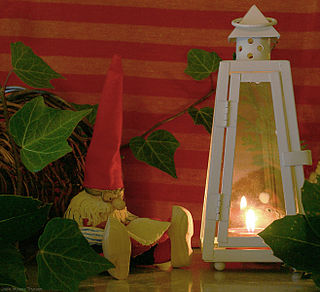
A nisse, tomte, tomtenisse, or tonttu is a mythological creature from Nordic folklore today typically associated with the winter solstice and the Christmas season. They are generally described as being short, having a long white beard, and wearing a conical or knit cap in gray, red or some other bright colour. They often have an appearance somewhat similar to that of a garden gnome.
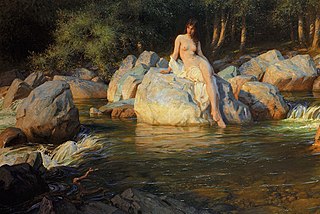
A kelpie, or water kelpie, is a shape-shifting spirit inhabiting lakes in Scottish folklore. It is a Celtic legend; however, analogues exist in other cultures. It is usually described as a black horse-like creature, able to adopt human form. Some accounts state that the kelpie retains its hooves when appearing as a human, leading to its association with the Christian idea of Satan as alluded to by Robert Burns in his 1786 poem "Address to the Devil".

A kobold is a sprite stemming from Germanic mythology and surviving into modern times in German folklore.
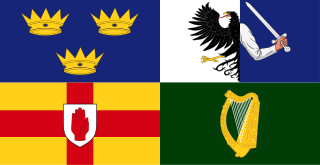
The púca, pooka, phouka is primarily a creature of Celtic folklore. Considered to be bringers both of good and bad fortune, they could help or hinder rural and marine communities. Púcaí can have dark or white fur or hair. The creatures were said to be shape-changers, which could take the appearance of horses, goats, cats, dogs, and hares. They may also take a human form, which includes various animal features, such as ears or a tail.
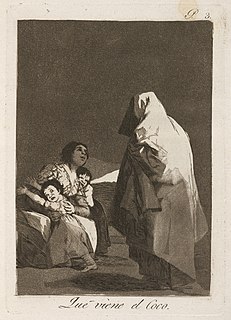
The Bogeyman is a type of mythical creature used by adults to frighten children into good behavior. Bogeymen have no specific appearance and conceptions vary drastically by household and culture, but they are most commonly depicted as masculine or androgynous monsters that punish children for misbehavior. The Bogeyman or conceptually similar monsters can be found in many cultures around the world. Bogeymen may target a specific act or general misbehaviour, depending on what purpose needs serving, often based on a warning from the child's authority figure. The term "Bogeyman" is sometimes used as a non-specific personification or metonym for terror, and in some cases, the Devil.

An imp is a European mythological being similar to a fairy or demon, frequently described in folklore and superstition. The word may perhaps derive from the term ympe, used to denote a young grafted tree.
Tiddy Mun was a legendary bog spirit in Lincolnshire, England, who was believed to have the ability to control the waters and mists of The Fens of South Lincolnshire and The Carrs of North Lincolnshire.

Dokkaebi are legendary creatures from Korean mythology and folklore. Dokkaebi, also known as "Korean goblins", are nature deities or spirits possessing extraordinary powers and abilities that are used to interact with humans, at times playing tricks on them and at times helping them. Legends describe different dokkaebi in many forms, and dokkaebi often wear hanbok.
The Buried Moon or The Dead Moon is a fairy tale included by Joseph Jacobs in More English Fairy Tales. It is an unusual tale, with few variants, and often appearing more mythological than is common for fairy tales. It was collected by Mrs. Balfour from the North Lincolnshire Carrs in the Ancholme Valley; its unusual characteristics made many people doubt its origins as a fairy tale. However, when Mrs. Balfour published her notes, they were generally found reliable, and the Fens proved to have many other unusual legends. The story may be the evidence of a form of moon worship.
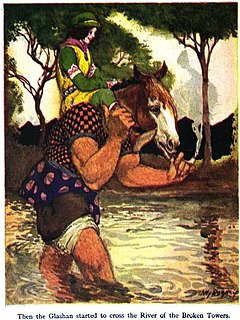
Glashtyn is a legendary creature from Manx folklore.

In folklore and fantasy, an enchanted forest is a forest under, or containing, enchantments. Such forests are described in the oldest folklore from regions where forests are common, and occur throughout the centuries to modern works of fantasy. They represent places unknown to the characters, and situations of liminality and transformation. The forest can feature as a place of threatening danger, or one of refuge, or a chance at adventure.
"Thumbling" and "Thumbling's Travels" are two German fairy tales collected by the Brothers Grimm in Grimm's fairy tales in 1819.
The moss people or moss folk, also referred to as the wood people or wood folk or forest folk, are a class of fairy folk, variously compared to dwarfs, elves, or spirits, described in the folklore of Germany as having an intimate connection to trees and the forest. In German the words Schrat and Waldschrat are also used for a moss person. The diminutive Schrätlein also serves as synonym for a nightmare creature.

A brownie or broonie (Scots), also known as a brùnaidh or gruagach, is a household spirit from Scottish folklore that is said to come out at night while the owners of the house are asleep and perform various chores and farming tasks. The human owners of the house must leave a bowl of milk or cream or some other offering for the brownie, usually by the hearth. Brownies are described as easily offended and will leave their homes forever if they feel they have been insulted or in any way taken advantage of. Brownies are characteristically mischievous and are often said to punish or pull pranks on lazy servants. If angered, they are sometimes said to turn malicious, like boggarts.

A goblin is a monstrous creature that appears in the folklore of multiple European cultures, first attested in stories from the Middle Ages. They are ascribed various and conflicting abilities, temperaments and appearances depending on the story and country of origin. They are almost always small and grotesque, mischievous or outright malicious, and greedy, especially for gold and jewelry. They often have magical abilities similar to a fairy or demon. Similar creatures include brownies, dwarfs, duendes, gnomes, imps, and kobolds.

"Master Cat or the Booted Cat", commonly known in English as "Puss in Boots", is an Italian and later European literary fairy tale about an anthropomorphic cat who uses trickery and deceit to gain power, wealth, and the hand of a princess in marriage for his penniless and low-born master.
In the folklore on the Anglo-Scottish border, the Brown Man of the Muirs is a dwarf who serves as a guardian spirit of wild animals.













